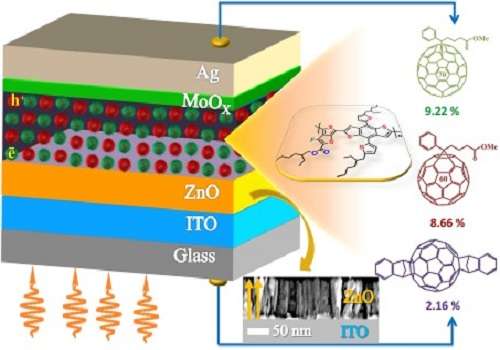Ultrafast charge separation

Polymers are an exciting prospect for use in solar cells because their manufacture is cheap, easily processed at low temperatures and can be scaled up for industrial production. A key drawback is their relatively low power conversion efficiency. A better understanding of light absorption and charge transfer dynamics in these materials is needed for their efficiency to match that of the more conventional silicon-based devices.
Omar Mohammed and his colleagues at the Solar & Photovoltaics Engineering Research Center (SPERC) at King Abdullah University of Science and Technology (KAUST), Saudi Arabia, study the ultrafast dynamics of photo-induced charge transfer and separation in a range of polymer–fullerene blends and harness this insight to develop a better approach to designing high-efficiency solar cells.
A common way to fabricate organic solar cells is to combine two different materials, known as a polymer–fullerene blend. Light absorbed in such a material induces charge transfer from the polymer "donor" to a fullerene "acceptor," a type of spherical molecule. This creates a positive charge on the donor component and a negative charge on acceptor components. The key consideration in solar cell optimization, therefore, is to effectively separate these two charges and thereby generate an electrical current.
Mohammed and his co-workers studied these crucial charge transfer and charge separation processes using transient absorption spectroscopy with broadband capability. This is a technique that measures the changes of a material's properties in response to short pulses of laser light, and in this way is able to monitor in real time electron dynamics on femtosecond (10-15 seconds) timescales.
"The main idea is to provide essential information on the mechanistic and kinetic details of the fundamental events that occur at device interfaces in polymer-fullerene systems," Mohammed said.
The researchers used a donor polymer called PTB7-Th and blended it with one of three different acceptors; PC71BM, PC61BM or IC60BA. They showed that the charge transfer process occurs in times shorter than one picosecond (10-12 seconds), and that the charge dynamics and solar-cell device performance are strongly dependent on the choice of acceptor. For example, a solar cell made with IC60BA exhibited a power conversion efficiency of only two percent, but the value was found to be over nine percent in a PC71BM-based device.
"This time-resolved technique is a unique pathway to study fundamental events that occur at device interfaces – saving time and effort in device optimization," Mohammed noted. "We next hope to extend this experiment to different polymers or even for solar cells based on inorganic photoactive materials."
More information: Qana A. Alsulami et al. Remarkably High Conversion Efficiency of Inverted Bulk Heterojunction Solar Cells: From Ultrafast Laser Spectroscopy and Electron Microscopy to Device Fabrication and Optimization, Advanced Energy Materials (2016). DOI: 10.1002/aenm.201502356
Journal information: Advanced Energy Materials
Provided by King Abdullah University of Science and Technology





















